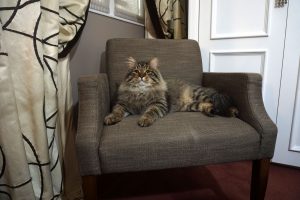
Interview with Tatiana Mamedova.
— What cats can be called “aboriginal”?
— Cats that are naturally developed in the wild. Aboriginals appear on a population of cats living only in a particular geographical territory. Different living conditions on the earth give unique aboriginal breeds from the different locations of the world. So, in Norway we have the Norwegian Forest Cat, in USA the Maine Coon and in Russia the Siberian Cat.
— So, does it only exist three aboriginal breeds?
— Oh no! There are significantly many more, and the talk about aboriginals is a separate big topic. They have one thing on common though – in Norway, USA, and Russia it was prohibited to breed aboriginals with other breeds in the very beginning of their development. Colours like lilac, chocolate and colour-point are not allowed.
— Who can be considered to be a breeder?
— For aboriginal breeds it’s a person whose work is concentrated on the selection of best producers, selection of pairs for breeding and preserving the qualities of the breed. This includes not letting “mixed” animals into breeding, animals whose origin is from a mix of breeds (I e Siberian/Persian, Siberian/Siamese).
— We know that you work with Siberian cats. What do Siberians look like?
— Now many will say: “We know how it looks, we have the same kind of cat at home!” Yes, house cats have some of the Siberian features, but unfortunately, there are not so many real Siberian cats. First of all, they are quite massive muscular cats on strong paws. They have heavy boning. Females are smaller than males. The weight of a female is 3-5 kg and more; the male – 6-9 kg and more. The males are dressed up more and look more luxurious: they have a nice volume of the collar in a form of a mane, splendid “trousers” and a fluffy tail. The fur of Siberian never gets tangled. The thick undercoat is “holding” the upper coat. The coat is shiny because of the upper hairs, it’s nice to touch, and semi long. It must never be very long. The head is in a form of wide trapezium, oval eyes widely and sidelong set, green or yellow-green. Some advantages of this breed are that it’s considered to be friendly, has a social character, good survival skills, excellent health and is faithful.
The colours of the Siberians are very different: tiger (or mackerel), marble (most refined) or without pattern, blue, smoke, cream, black, and others. There is always a pattern in the form of the letter “M” on the forehead of the cats with patterned (tabby) colours, there are also waves on the cheeks and circles on the chest, stripes on the tail and paws. It is not without a reason that the Siberian cat is called “the fluffy miracle of Russia.”
— What do you think about the Neva-Masquerade cats?
— The appearance of these cats was met with interest. The cats look like Siberians but with Siamese colours. Dark points on the muzzle, tail and paws look quite luxurious. The owners were insisting that it’s a “Siberian” cat, that a “Himalayan gene” was found in the Siberian cat — and the Neva-Masquerade is the result. All this, of course, is made up, and has nothing in common with the genetics of the Siberians. In the beginning there were not too many of those cats; that’s why they were “quietly” allowed to be at the exhibitions together with Siberians. Soon, everything was explained very simple: the first cats of Siamese colours appeared in Russia in 1970es. A couple of those cats were brought by the leader of the puppet theatre Sergey Obraztsov. So, by breeding Siberians with Siamese we got the Neva-Masquerade cat. And when the first Persians were brought to Russia, some “cat lovers” bred Nevas with colour-point Persians right away, in this way they decided to “improve” fur, to make it longer. Maybe it’s beautiful, but it’s already another breed, as we said before, it’s prohibited to mix Siberians with any other breed! No doubts, for these cats it’s needed to register a new breed, if it will be considered necessary. The quality of the fur and the whole look – the head and boning of this cat is absolutely different. It’s necessary to separate this breed from Siberian and be honest about its appearance. Elena Shevchenko (expert IFA-IFC-ICJF) explained this very well in one of her articles:
“Americans didn’t start to breed Maine Coon with colour-points to get “Hudson-Festivals.” And none of the systems neither in USA, nor in Europe (except WCF) accept this breed as Siberian. All countries are preserving their aboriginal breeds and are proud of them, not allowing mixing of other breeds with aboriginals, only here – in Russia everything is allowed. Truly said, “What we have – we don’t preserve, as we lose it – we cry.”
At the exhibitions abroad in any country Siberians are greeted with wonder, and kittens are bought with pleasure. If there is no separation between those two breeds, we will soon have to buy Siberians abroad.